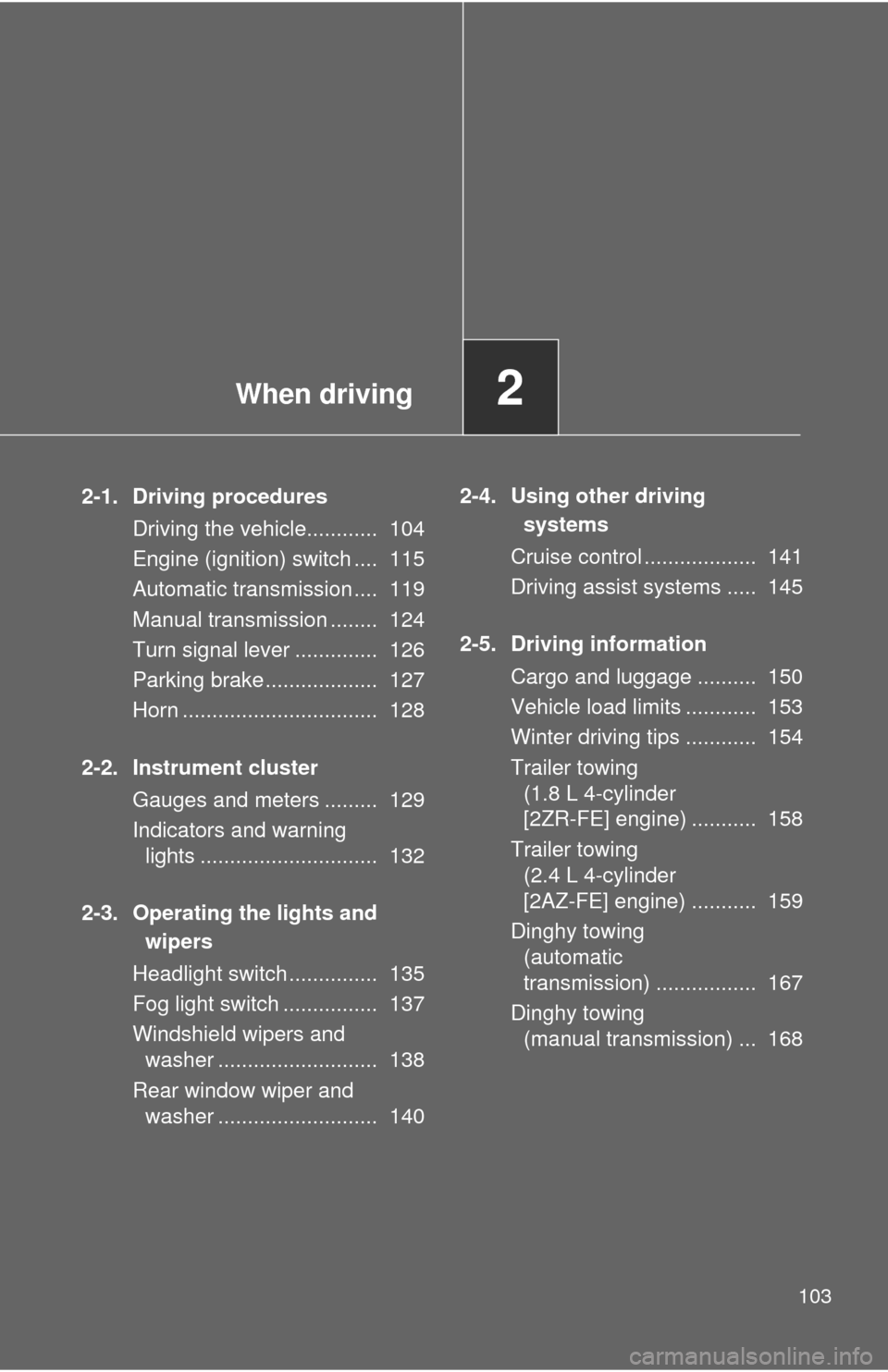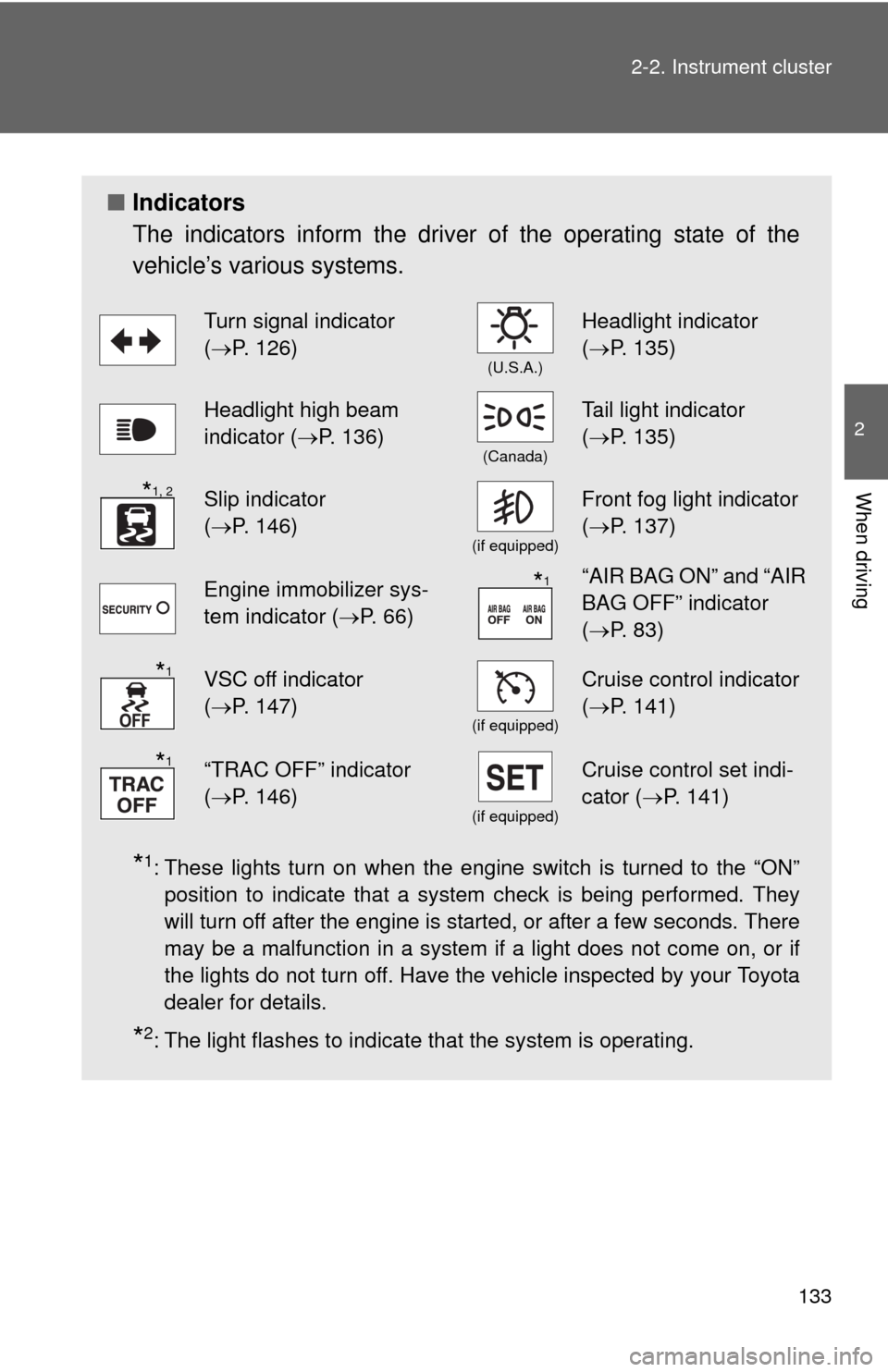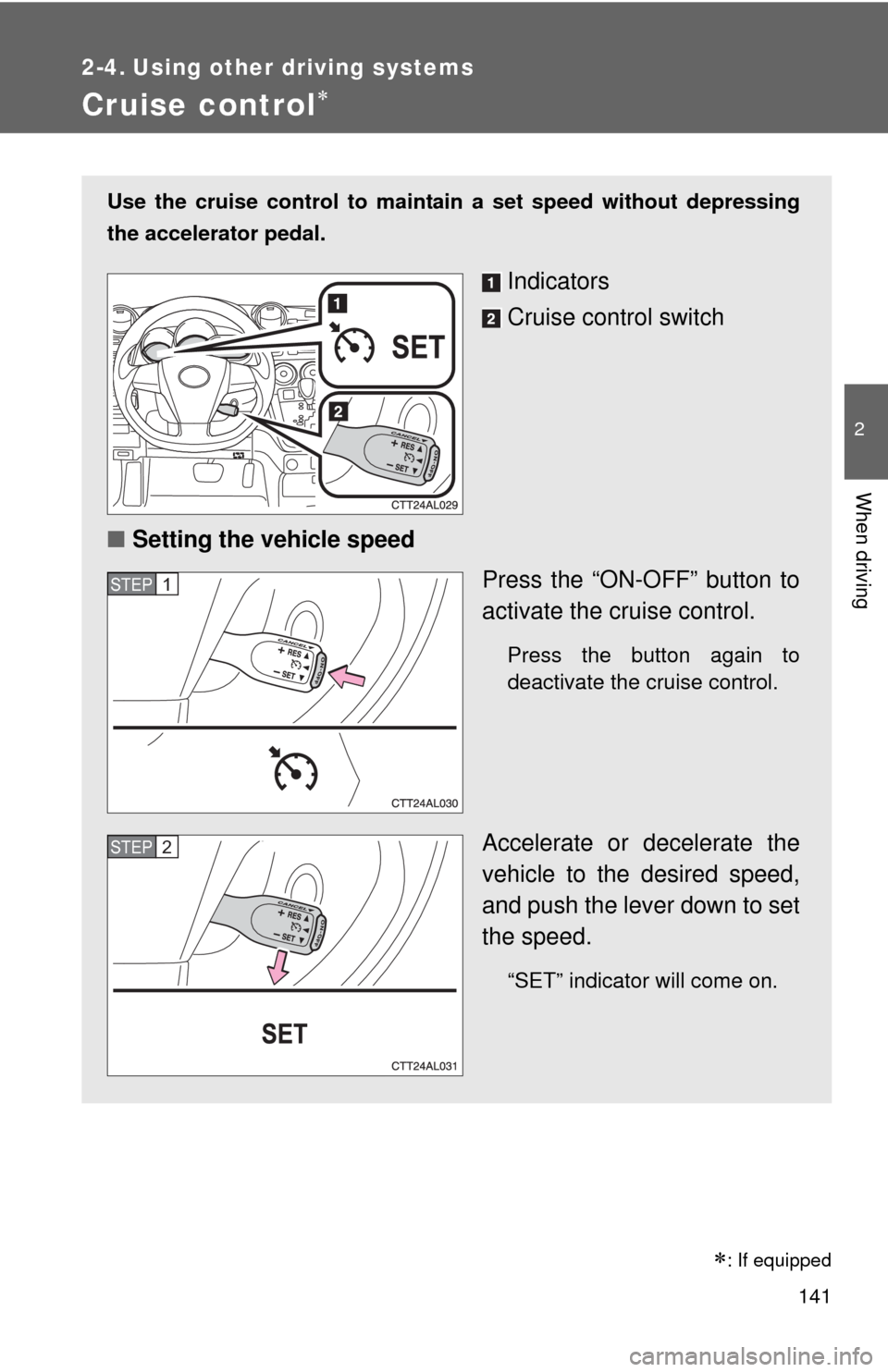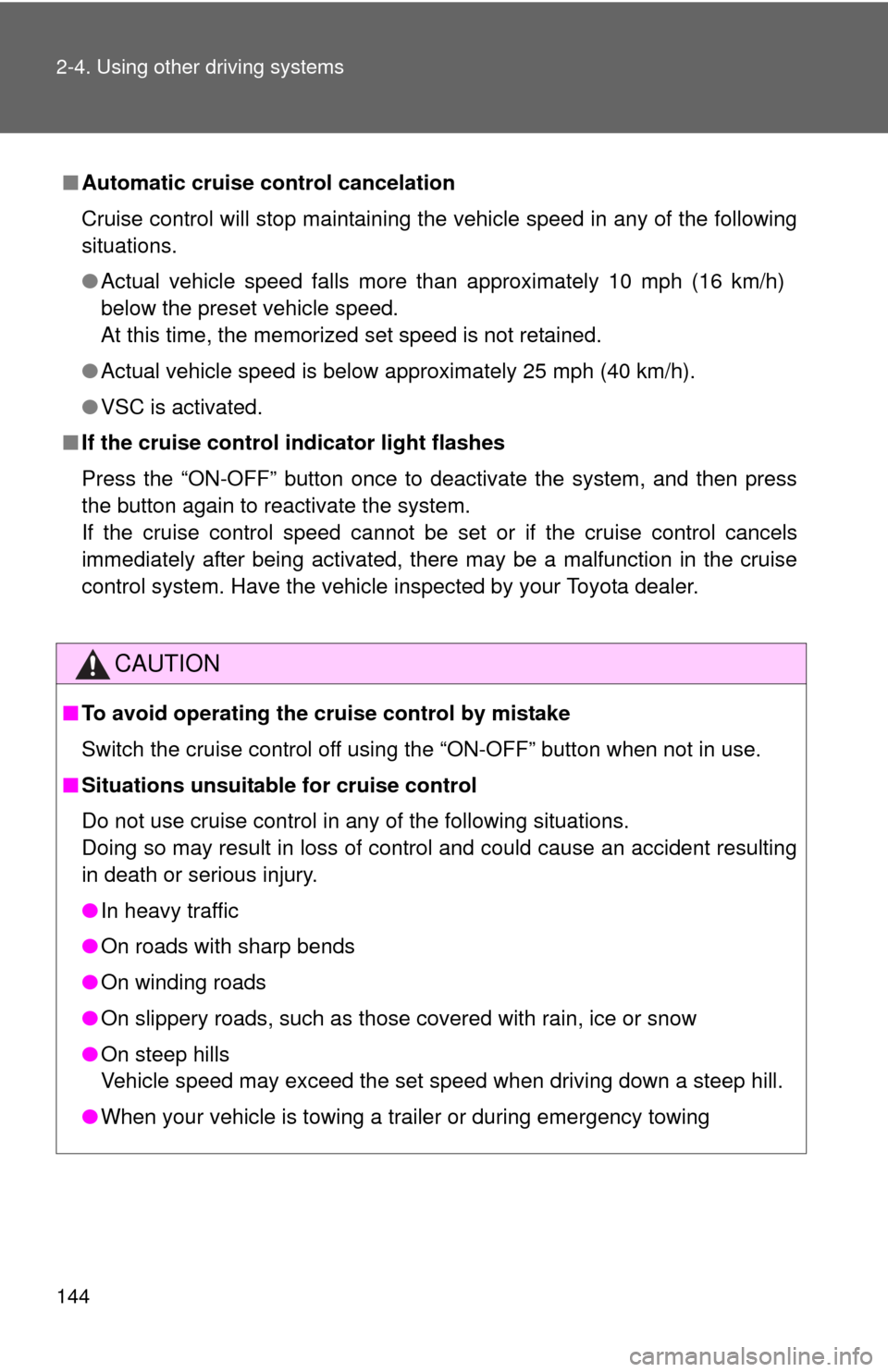cruise control TOYOTA MATRIX 2011 E140 / 2.G Owners Manual
[x] Cancel search | Manufacturer: TOYOTA, Model Year: 2011, Model line: MATRIX, Model: TOYOTA MATRIX 2011 E140 / 2.GPages: 501, PDF Size: 11.47 MB
Page 3 of 501

1
2
3
4
5
6
7
3
2-4. Using other driving
systems
Cruise control
...................... 141
Driving assist systems ........ 145
2-5. Driving information Cargo and luggage ............. 150
Vehicle load limits ............... 153
Winter driving tips ............... 154
Trailer towing (1.8 L 4-cylinder
[2ZR-FE] engine) .............. 158
Trailer towing (2.4 L 4-cylinder
[2AZ-FE] engine) .............. 159
Dinghy towing (automatic transmission) .................... 167
Dinghy towing (manual transmission) .................... 168
3-1.
Using the air conditioning
system a
nd defogger
Air conditioning system ....... 172
Rear window and outside rear view
mirror defoggers ............... 179
3-2. Using the audio system Audio system types ............. 180
Using the radio .................... 183
Using the CD player ............ 190
Playing MP3 and WMA discs.................................. 197
Operating an iPod ............... 206 Operating a USB
memory ............................ 213
Optimal use of the audio system .............................. 221
Using the AUX port............. 225
Using the steering wheel audio switches.................. 227
3-3. Using the Bluetooth
®
audio s
ystem
Bluetooth
® audio system .... 230
Using the Bluetooth®
audio system .................... 233
Operating a Bluetooth
®
enabled portable player.... 239
Setting up a Bluetooth
®
enabled portable player.... 241
Bluetooth
® audio system
setup ................................ 246
3-4. Using the ha
nds-free
phone system
(
for cellular phone)
Hands-free phone system (for cellular phone)
features ............................ 247
Using the hands-free phone system
(for cellular phone) ........... 252
Making a phone call ........... 262
Setting a cellular phone ...... 266
Security and system setup ................................ 271
Using the phone book ........ 275
3Interior features
Page 15 of 501

15
B
Cruise control switch P. 141
Talk switch P. 253
Engine (ignition) switch P. 115
Audio remote control
switches
P. 227
: If equipped
Telephone switches
P. 253
Page 19 of 501

19
Installation of a mobile two-way radio system
As the installation of a mobile two-way radio system in your vehicle may
affect electronic systems such as the multi-port fuel injection system/sequen-
tial multi-port fuel injection system, cruise control system, anti-lock brake
system, SRS airbag system or seat belt pretensioner system, be sure to
check with your Toyota dealer for precautionary measures or special instruc-
tions regarding installation.
Scrapping of your Toyota
The SRS airbag and seat belt pretensioner devices in your Toyota contain
explosive chemicals. If the vehicle is scrapped with the airbags and seat belt
pretensioners left as they are, this may cause an accident such as fire. Be
sure to have the systems of the SRS airbag and seat belt pretensioner
removed and disposed of by a qualified service shop or by your Toyota
dealer before you scrap your vehicle.
Perchlorate Material
Special handling may apply, See www.dtsc.ca.gov/hazardouswaste/perchlorate.
Your vehicle has components that may contain perchlorate. These compo-
nents may include airbags, seat belt pretensioners, and wireless remote con-
trol batteries.
Page 103 of 501

When driving2
103
2-1. Driving procedures
Driving the vehicle............ 104
Engine (ignition) switch .... 115
Automatic transmission .... 119
Manual transmission ........ 124
Turn signal lever .............. 126
Parking brake ................... 127
Horn ................................. 128
2-2. Instrument cluster
Gauges and meters ......... 129
Indicators and warning
lights .............................. 132
2-3. Operating the lights and
wipers
Headlight switch ............... 135
Fog light switch ................ 137
Windshield wipers and
washer ........................... 138
Rear window wiper and
washer ........................... 1402-4. Using other driving
systems
Cruise control ................... 141
Driving assist systems ..... 145
2-5. Driving information
Cargo and luggage .......... 150
Vehicle load limits ............ 153
Winter driving tips ............ 154
Trailer towing
(1.8 L 4-cylinder
[2ZR-FE] engine) ........... 158
Trailer towing
(2.4 L 4-cylinder
[2AZ-FE] engine) ........... 159
Dinghy towing
(automatic
transmission) ................. 167
Dinghy towing
(manual transmission) ... 168
Page 123 of 501

123 2-1. Driving procedures
2
When driving
■Downshifting restrictions warning buzzer (S mode in multi-mode type)
To help ensure safety and driving performance, downshifting operation may
sometimes be restricted. In some circumstances, downshifting may not be
possible even when the shift lever is operated. (The warning buzzer will
sound twice.)
■When driving with the cruise control system (if equipped)
Standard type
Engine braking will not occur when downshifting from D to 3. (P. 141)
Multi-mode type
Engine braking will not occur in S mode, even when downshifting to 4.
(P. 141)
■If the shift lever cannot be shifted from P
P. 426
■If the “S” indicator does not come on even after shifting the shift lever
to S (multi-mode type)
This may indicate a malfunction in the automatic transmission system. Have
the vehicle inspected by your Toyota dealer immediately.
(In this situation, the vehicle will operate as if the shift lever is in D.)
■AI-SHIFT
AI-SHIFT automatically selects the optimal gear according to driver perfor-
mance and driving conditions.
Standard type
AI-SHIFT automatically operates when the shift lever is in the D position.
Multi-mode type
AI-SHIFT automatically operates when the shift lever is in the D position.
(Shifting the shift lever to the S position cancels the function.)
Page 133 of 501

133 2-2. Instrument cluster
2
When driving
■Indicators
The indicators inform the driver of the operating state of the
vehicle’s various systems.
*1: These lights turn on when the engine switch is turned to the “ON”
position to indicate that a system check is being performed. They
will turn off after the engine is started, or after a few seconds. There
may be a malfunction in a system if a light does not come on, or if
the lights do not turn off. Have the vehicle inspected by your Toyota
dealer for details.
*2: The light flashes to indicate that the system is operating.
Turn signal indicator
(P. 126)
(U.S.A.)
Headlight indicator
(P. 135)
Headlight high beam
indicator (P. 136)
(Canada)
Tail light indicator
(P. 135)
Slip indicator
(P. 146)
(if equipped)
Front fog light indicator
(P. 137)
Engine immobilizer sys-
tem indicator (P. 66)“AIR BAG ON” and “AIR
BAG OFF” indicator
(P. 83)
VSC off indicator
(P. 147)
(if equipped)
Cruise control indicator
(P. 141)
“TRAC OFF” indicator
(P. 146)
(if equipped)
Cruise control set indi-
cator (P. 141)
*1, 2
*1
*1
*1
Page 141 of 501

141
2
When driving
2-4. Using other driving systems
Cruise control
Use the cruise control to maintain a set speed without depressing
the accelerator pedal.
Indicators
Cruise control switch
■Setting the vehicle speed
Press the “ON-OFF” button to
activate the cruise control.
Press the button again to
deactivate the cruise control.
Accelerate or decelerate the
vehicle to the desired speed,
and push the lever down to set
the speed.
“SET” indicator will come on.
STEP1
STEP2
�
: If equipped
Page 143 of 501

143 2-4. Using other driving systems
2
When driving
■Cruise control can be set when
●Automatic transmission:
The shift lever is in the D or “3” range (standard type), or in the D or
range “4” or higher of S has been selected (multi-mode type).
●Vehicle speed is above approximately 25 mph (40 km/h).
■Accelerating
The vehicle can be accelerated normally. After acceleration, the set speed
resumes.
■Canceling and resuming the constant speed control
Pulling the lever toward you
cancels the constant speed
control.
The speed setting is also can-
celed when the brakes are
applied or the clutch pedal
(manual transmission only) is
depressed.
Pushing the lever up
resumes the constant
speed control.
Resuming is available when
the vehicle speed is more
than approximately 25 mph
(40 km/h).
Page 144 of 501

144 2-4. Using other driving systems
■Automatic cruise control cancelation
Cruise control will stop maintaining the vehicle speed in any of the following
situations.
●Actual vehicle speed falls more than approximately 10 mph (16 km/h)
below the preset vehicle speed.
At this time, the memorized set speed is not retained.
●Actual vehicle speed is below approximately 25 mph (40 km/h).
●VSC is activated.
■If the cruise control indicator light flashes
Press the “ON-OFF” button once to deactivate the system, and then press
the button again to reactivate the system.
If the cruise control speed cannot be set or if the cruise control cancels
immediately after being activated, there may be a malfunction in the cruise
control system. Have the vehicle inspected by your Toyota dealer.
CAUTION
■To avoid operating the cruise control by mistake
Switch the cruise control off using the “ON-OFF” button when not in use.
■Situations unsuitable for cruise control
Do not use cruise control in any of the following situations.
Doing so may result in loss of control and could cause an accident resulting
in death or serious injury.
●In heavy traffic
●On roads with sharp bends
●On winding roads
●On slippery roads, such as those covered with rain, ice or snow
●On steep hills
Vehicle speed may exceed the set speed when driving down a steep hill.
●When your vehicle is towing a trailer or during emergency towing
Page 404 of 501

5
When trouble arises
403 5-2. Steps to take in an emergency
(U.S.A.)
(Canada)ABS warning light
Indicates a malfunction in:
•ABS; or
• The brake assist system.
Electric power steering warning light (warning buzzer)
Indicates a malfunction in the EPS system.
Slip indicator light
Indicates a malfunction in:
• The VSC system; or
• The TRAC system.
(Flashes)Cruise control indicator light (if equipped)
Indicates a malfunction in the cruise control system.
(AWD models)Active Torque Control 4WD system warning light
Indicates a malfunction in the Active Torque Control 4WD
system.
■If the malfunction indicator lamp comes on while driving
First check the following:
●Is the fuel tank empty?
If it is, fill the fuel tank immediately.
●Is the fuel tank cap loose?
If it is, tighten it securely.
The malfunction indicator lamp will go off after taking several driving trips.
If the malfunction indicator lamp does not go off even after several trips, con-
tact your Toyota dealer as soon as possible.
Warning lightWarning light/Details